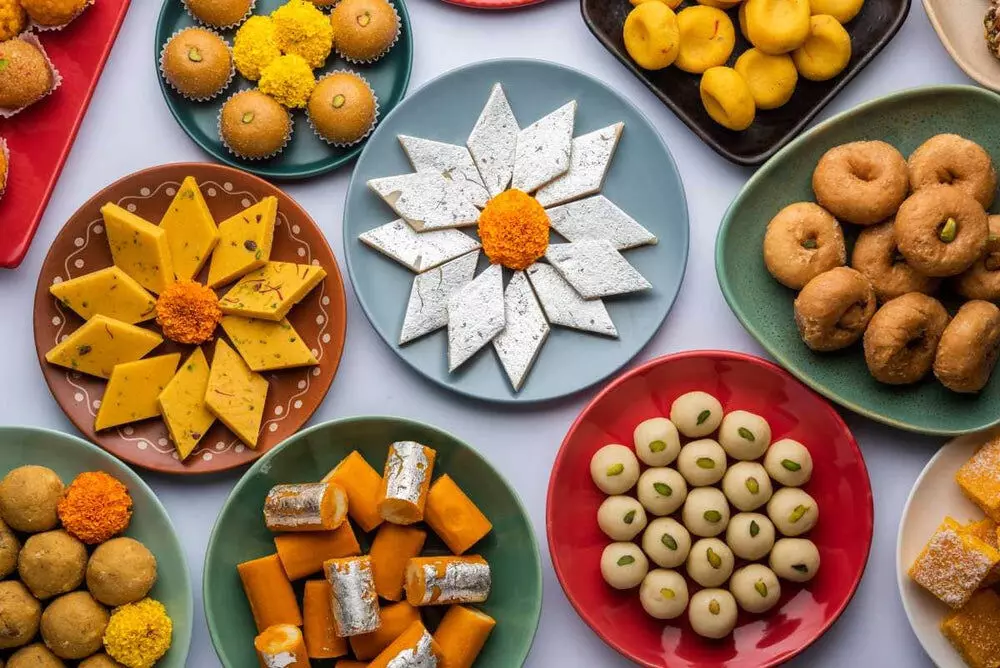Cakes to shakes: 51% urban Indian households consume traditional Indian sweets 3 times a month
LocalCircles conducted a survey to find out if there had been any change in the sugar consumption pattern of Indian households
By Sri Lakshmi Muttevi
Representational Image.
Hyderabad: Festive season is here and sweets are making the celebrations sweeter.
Not to be surprised, consumption of sweets in urban Indian households rose from 41% in 2023 to 51% per month in 2024
With the festive season starting soon, a study finds that brands with lower sugar variants may have an advantageous positioning.
When it comes to sugar consumption, India is witnessing a notable increase which is indicative of rising demand every year within the country, the Department of Food & Public Distribution (DFPD) reveals.
DFPD has stated that annual sugar consumption in India has reached around 290 lakh (29 million) tonnes (LMT) annually.
The sugar consumption volume has been increasing gradually. In 2019-20, it was over 28 million metric tons.
While the overall consumption of sugar in the country is rising there is also a growing market catering to demand for sugar-free products especially in traditional Indian sweets and ice-creams.
Some no-sugar variants have also been launched by brands across several food categories where the natural sugar of dates, figs, and jaggery are used as sweeteners. However, one area that most brands haven’t paid attention to is rolling out lower-sugar versions of their regular products.
LocalCircles conducted a survey to find out if there had been any change in the sugar consumption pattern of Indian households. If so, whether there is any shift from traditional sweets to other products containing sugar. It also attempted to understand via the survey, the acceptability of lower sugar products amongst Indian household consumers.
The survey received over 36,000 responses from household consumers located in 311 districts of India. 61% of respondents were men while 39% of respondents were women. 42% of respondents were from tier 1, 29% were from tier 2 and 29% respondents were from tier 3 & 4 districts.
Sweet after a meal:
Having something sweet to eat after a meal is nothing unusual in most families unless health conditions don’t permit it.
51% urban Indian households consume traditional Indian sweets 3 or more times a month. Percentage of urban Indian households surveyed that consume traditional.
Study shows 10% indicating that they eat traditional Indian sweets “every day”; 6% of respondents indicated “15-30 times a month”; 8% of respondents indicated “8-15 times a month”; 27% of respondents indicated “3-7 times a month”; and 39% indicated “1-2 times a month”.
Packaged products:
56% of urban Indian households consume bakery and packaged products like cakes, biscuits, ice-creams, shakes, chocolates, candies, etc., 3 or more times a month; 18% consume them every day.
Global studies show that there is a shift seen in the percentage of households that are buying processed food products containing less sugar for varied reasons.
What percentage of sugar can be cut?
55% of urban Indian household consumers surveyed believe that they will be fine with consuming traditional sweets, sweet bakery, and packaged products with sugar content that is lower by 25-75% of the current levels.
In summary, 51% urban Indian households consume traditional Indian sweets 3 or more times a month.
According to the survey, 56% of urban Indian households consume cakes, biscuits, ice creams, shakes, chocolates, candies, etc. 3 or more times a month; 18% consume them every day.
With many consumers expressing through the course of this year about the need for brands to develop lower sugar product alternatives as they found sugar in many products to be excessive, the survey found that 55% of urban Indian household consumers believe that they will be fine with consuming traditional sweets, sweet bakery, and packaged products with sugar content that is lower by 25-75%.